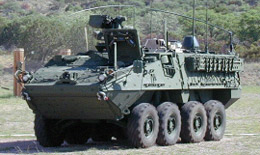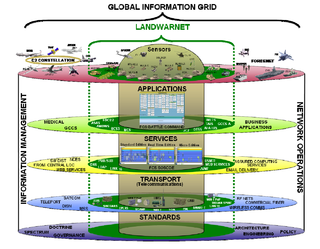
The United States Air Force (USAF) is the air service branch of the United States Armed Forces, and is one of the eight uniformed services of the United States. Originally created on 1 August 1907, as a part of the United States Army Signal Corps, the USAF was established as a separate branch of the United States Armed Forces in 1947 with the enactment of the National Security Act of 1947. It is the second youngest branch of the United States Armed Forces and the fourth in order of precedence. The United States Air Force articulates its core missions as air supremacy, global integrated intelligence, surveillance and reconnaissance, rapid global mobility, global strike, and command and control.

Civil-Military Co-operation (CIMIC) is the means by which a military commander connects with civilian agencies active in a theater of operations.

A military staff or general staff is a group of officers, enlisted and civilian staff who serve the commander of a division or other large military unit in their command and control role through planning, analysis, and information gathering, as well as by relaying, coordinating, and supervising the execution of their plans and orders, especially in case of multiple simultaneous and rapidly changing complex operations. They are organised into functional groups such as administration, logistics, operations, intelligence, training, etc. They provide multi-directional flow of information between a commanding officer, subordinate military units and other stakeholders. A centralised general staff results in tighter top-down control but requires larger staff at headquarters (HQ) and reduces accuracy of orientation of field operations, whereas a decentralised general staff results in enhanced situational focus, personal initiative, speed of localised action, OODA loop, and improved accuracy of orientation.
Mission-type tactics are military tactics where the emphasis is placed on the outcome of a mission rather than on specific methods. Mission-type tactics have been a central component of German armed forces' military tactics since the 19th century.
The Army Battle Command System (ABCS) is a digital Command, Control, Communications, Computers and Intelligence (C4I) system for the US Army. It includes a mix of fixed/semi-fixed and mobile networks. It is also designed for interoperability with US and Coalition C4I systems.

NetOps is defined as the operational framework consisting of three essential tasks, Situational Awareness (SA), and Command & Control (C2) that the Commander (CDR) of US Strategic Command (USSTRATCOM), in coordination with DoD and Global NetOps Community, employs to operate, manage and defend the Global Information Grid (GIG) to ensure information superiority for the United States.
Global Command and Control System (GCCS) is the United States' armed forces DoD joint command and control (C2) system used to provide accurate, complete, and timely information for the operational chain of command for U.S. armed forces. "GCCS" is most often used to refer to the computer system, but actually consists of hardware, software, common procedures, appropriation, and numerous applications and interfaces that make up an "operational architecture" that provides worldwide connectivity with all levels of command. GCCS incorporates systems that provide situational awareness, support for intelligence, force planning, readiness assessment, and deployment applications that battlefield commanders require to effectively plan and execute joint military operations.
Battlespace or battle-space is a term used to signify a military strategy which integrates multiple armed forces for the military theatre of operations, including air, information, land, sea, cyber and outer space to achieve military goals. It includes the environment, factors, and conditions that must be understood to successfully apply combat power, protect the force, or complete the mission. This includes enemy and friendly armed forces, infrastructure, weather, terrain, and the electromagnetic spectrum within the operational areas and areas of interest.

Psychological operations (PSYOP) are operations to convey selected information and indicators to audiences to influence their emotions, motives, and objective reasoning, and ultimately the behavior of governments, organizations, groups, and individuals.

The M1130 Commander Vehicle (CV) is an armored command vehicle based on the Stryker platform. It is used within the brigade to provide means to receive information, analyze and transmit data, and control forces carrying out combat missions. Models with the double V-hull upgrade are known as the M1255 CVV.

Blue force tracking is a United States military term for a GPS-enabled capability that provides military commanders and forces with location information about friendly military forces. In NATO military symbology, blue typically denotes friendly forces. The capability provides a common picture of the location of friendly forces and therefore is referred to as the blue force tracker. When all capitalized, the term refers to a specific defense contractors' system, but the capability is found in many military and civilian mobile apps.
LandWarNet (LWN) is the United States Army’s contribution to the Global Information Grid (GIG) that consists of all globally interconnected, end-to-end set of Army information capabilities, associated processes, and personnel for collecting, processing, storing, disseminating, and managing information on demand supporting warfighters, policy makers, and support personnel. It includes all Army and leveraged Department of Defense (DOD)/Joint communications and computing systems and services, software, data security services, and other associated services. LandWarNet exists to enable the warfighter through Mission Command, previously described as Battle Command. Other U.S. service equivalent efforts to LandWarNet include the Navy's "FORCEnet" and the Air Force's "C2 Constellation."

The FCS Network - Brigade Combat Team (BCT) Network consists of five layers that deliver data to forward-deployed Army units.
Within military operations, a local operational picture (LOP) is a single identical display of relevant (operational) information of the battlespace constructed for local use.

Battle command (BC) is the discipline of visualizing, describing, directing, and leading forces in operations against a hostile, thinking, and adaptive enemy. Battle command applies leadership to translate decision into actions, by synchronizing forces and warfighting functions in time, space, and purpose, to accomplish missions. Battle command refers both to processes triggered by commanders and executed by soldiers and to the system of systems (SoS) that directly enables those processes.

PM WIN-T is a component of Program Executive Office Command, Control and Communications-Tactical in the United States Army. PM WIN-T has been absorbed into PM Tactical Networks as Product Manager for Mission Networks.

The Army will continue the development and fielding of an incremental ground tactical network capability to all Army brigade combat teams. This network is a layered system of interconnected computers and software, radios, and sensors within the Brigade Combat Team (BCT). The BCT network is essential to enable Unified Battle Command and will be delivered to the Army's Brigade Combat Teams in increasing capability increments. The first increment is currently finishing SDD developmental and operational testing and will be delivered to Infantry Brigade Combat Teams in the form of Network Integration Kits (B-kits) with E-IBCT.

Project Manager Mission Command is a component of Program Executive Office Command, Control and Communications-Tactical in the United States Army. PM MC develops, deploys and sustains integrated Mission Command software capabilities for the Army and Joint forces. PM MC’s support ensures tactical and other unit types are efficiently fielded, effectively trained, and professionally supported. Product lines include the areas of maneuver, fires, sustainment, and infrastructure.

Federated Mission Networking (FMN) is a significant initiative to help ensure interoperability and operational effectiveness of the North Atlantic Treaty Organization, it is a key contribution to the Connected Forces Initiative, helping Allied and Partner forces to better communicate, train and operate together. This includes the NATO Command Structure as well as the NATO Force Structure. The purpose of FMN is ultimately to support Command, Control, Communications, Computers, Intelligence, Surveillance and Reconnaissance (C4ISR) and decision-making in operations by enabling a rapid instantiation of mission networks. Including the NATO Command Structure, 37 nations have joined the FMN initiative as so called "FMN Affiliates" and work together under the FMN Framework Process to coordinate the design, development and delivery of operational and technical capabilities required to conduct net-centric operations. Each development increment is referred to as an "FMN Spiral". The respective requirements, architecture, standards, procedural and technical instructions are documented in so called "FMN Spiral Specifications". FMN Spiral Specifications are based on well known standards and best practices, hence supported by most off-the-shelf products and vendor neutral. TACOMS standards and profiles specify a common, technology and topology independent network interoperability layer for federated mission networks. There is also a rolling 10-year FMN Spiral Specification Roadmap of the envisioned future capabilities. At the same time, the Coalition Interoperability Assurance and Validation (CIAV) process ensures that current interoperability issues are being identified and fed back into FMN capability development.












